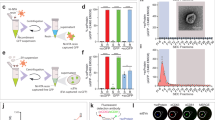Play all audios:

ABSTRACT Potential problems with the use of viral vectors for gene therapy necessitate the development of efficient nonviral vectors. The association of transferrin, or the pH-sensitive
peptide GALA, with cationic liposomes composed of 1,2-dioleoyl-3-(trimethylammonium) propane and its equimolar mixture with dioleoylphosphatidylethanolamine, under conditions where the
liposome/DNA complex is negatively charged, drastically increased luciferase expression from pCMVluc. The percentage of cells transfected, measured by β-galactosidase expression, was also
increased by about 10-fold. The zeta potential of the ternary complexes was lower than that of the liposome/DNA complexes. Transfection activity of positively charged complexes was also
enhanced by association with transferrin, GALA or the influenza hemagglutinin N terminal peptide HA-2, but to a smaller extent compared with the negatively charged complexes. The enhancement
of gene delivery by transferrin or GALA was not affected significantly by the presence of serum and did not cause significant cytotoxicity. Our results indicate that negatively charged
ternary complexes of cationic liposomes, DNA and transferrin, or fusigenic peptides, can facilitate efficient transfection of cultured cells, and that they may alleviate the drawbacks of the
use of highly positively charged complexes for gene delivery in vivo. Access through your institution Buy or subscribe This is a preview of subscription content, access via your institution
ACCESS OPTIONS Access through your institution Subscribe to this journal Receive 6 print issues and online access $259.00 per year only $43.17 per issue Learn more Buy this article *
Purchase on SpringerLink * Instant access to full article PDF Buy now Prices may be subject to local taxes which are calculated during checkout ADDITIONAL ACCESS OPTIONS: * Log in * Learn
about institutional subscriptions * Read our FAQs * Contact customer support SIMILAR CONTENT BEING VIEWED BY OTHERS EXOGENOUS LOADING OF EXTRACELLULAR VESICLES, VIRUS-LIKE PARTICLES, AND
LENTIVIRAL VECTORS WITH SUPERCHARGED PROTEINS Article Open access 19 May 2022 THE 60-YEAR EVOLUTION OF LIPID NANOPARTICLES FOR NUCLEIC ACID DELIVERY Article 04 July 2024 STRUCTURING LIPID
NANOPARTICLES, DNA, AND PROTEIN CORONA INTO STEALTH BIONANOARCHITECTURES FOR IN VIVO GENE DELIVERY Article Open access 23 October 2024 AUTHOR INFORMATION AUTHORS AND AFFILIATIONS *
Department of Microbiology, School of Dentistry, University of the Pacific, San Francisco, CA, USA S Simões, V Slepushkin & N Düzgüneş * Laboratory of Pharmaceutical Technology, Faculty
of Pharmacy, Portugal S Simões & R Gaspar * Center for Neurosciences, University of Coimbra, Portugal S Simões & MC Pedroso de Lima * Department of Biochemistry, University of
Coimbra, Portugal R Gaspar & MC Pedroso de Lima Authors * S Simões View author publications You can also search for this author inPubMed Google Scholar * V Slepushkin View author
publications You can also search for this author inPubMed Google Scholar * R Gaspar View author publications You can also search for this author inPubMed Google Scholar * MC Pedroso de Lima
View author publications You can also search for this author inPubMed Google Scholar * N Düzgüneş View author publications You can also search for this author inPubMed Google Scholar RIGHTS
AND PERMISSIONS Reprints and permissions ABOUT THIS ARTICLE CITE THIS ARTICLE Simões, S., Slepushkin, V., Gaspar, R. _et al._ Gene delivery by negatively charged ternary complexes of DNA,
cationic liposomes and transferrin or fusigenic peptides. _Gene Ther_ 5, 955–964 (1998). https://doi.org/10.1038/sj.gt.3300674 Download citation * Received: 09 October 1997 * Accepted: 10
February 1998 * Published: 10 July 1998 * Issue Date: 01 July 1998 * DOI: https://doi.org/10.1038/sj.gt.3300674 SHARE THIS ARTICLE Anyone you share the following link with will be able to
read this content: Get shareable link Sorry, a shareable link is not currently available for this article. Copy to clipboard Provided by the Springer Nature SharedIt content-sharing
initiative KEYWORDS * gene delivery * cationic liposomes * transferrin * fusigenic peptides
